 zachary harden
zachary harden
Keywords: myanmar | burma | arakan | kachin | karenni | pa-o | lahu | wa | palaung | mon | karen | kawthoolei | chin | naga | rohingya |
Links: FOTW homepage | search | disclaimer and copyright | write us | mirrors

Last modified: 2024-12-21 by  zachary harden
zachary harden
Keywords: myanmar | burma | arakan | kachin | karenni | pa-o | lahu | wa | palaung | mon | karen | kawthoolei | chin | naga | rohingya |
Links: FOTW homepage |
search |
disclaimer and copyright |
write us |
mirrors
"Myanmar is a federal republic made of seven purely burmese divisions (Sagaing, Mandalay, Magwe, Pegu, Irrawaddy, Rangoon, Tenasserim) and seven states with non-burmese population (Kachin, Chan, Kayah, Karen, Mon, Arakan, Chin). National unity was not really achieved due to the diversity of populations. Burmese are mongoloid peoples speaking a language of the tibeto-burmese group, and represent 75% of the population, and up to 80% when including Arakans, who speak the same language but were more or less influenced by Islam, and Tenasserim Mo^ns, who speak a mo^n-khmer language and greatly influenced the Burmese civilization. Burmese are theravada buddhists.Chan (1,500,000 ?) are Tha, related to Siamese, and also theravada buddhists. They have preserved a feudal organization and dominate proto-indochinese minorities
Kachin of the mountains (450,000 ?) speak a tibeto-burmese language but were not influenced by Indians. They are animists or christians.
Chin tribes (400, 000?) are also of tibeto-burmese language but remain very primitive, and their dialects differ from one valley to the other.
Karen (2,000,000 ?) of the mountains speak a language close to burmese but are animists and partially christianised."[eun]
Ivan Sache, 16 Sep 1999
The flags shown here are probably those of organizations engaged in a struggle against the Myanmar government, as the designs do not coincide with the "official" flags of the states as illustrated in Burmese postage stamps of 1974.
The following tribes and peoples have reported flags:
See also:
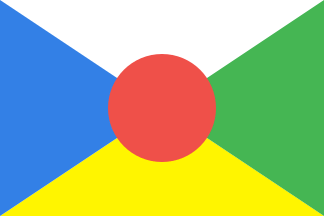
Tomislav Todorovic, 17 March 2024
In Myanmar there's some cultural and literary organizations that cover the task of a national movement. The Akha Literature and Culture Association flag is in fact used also as national Akha flag (only in Myanmar, in Thailand the Akha use a different flag). [Here], this flag is reported as Akha National Development Party and certainly this party use widely the Akha flag, but they have a party flag too.
Jaume Ollé, 09 March 2024
As the photos of the Akha Literature and Culture Association flag reveal, its ratio, disc site and color shades vary somewhat, but most frequently, the ratio is about 2:3, the disc size is about 1/2 of the flag width, the shades of red and green are approximately the same and yellow is lighter than in the national flag of Myanmar. Blue is also usually in a lighter shade.Tomislav Todorovic, 17 March 2024
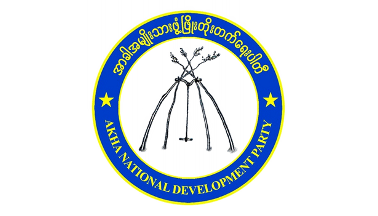 Akha National Development Party
Akha National Development Party
Tomislav Todorovic, 17 March 2024
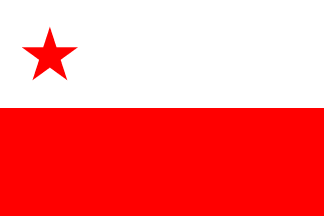 image by António Martins-Tuválkin, 26 May 2016
image by António Martins-Tuválkin, 26 May 2016
This flag (based on Crampton (1990), if I remember right) corresponds to the National United Front of Arakan (NUFA), the principal military organization of the State of Arakan, with more than two hundred regular soldiers, the majority Arakanese with some Chin and Rohingas. The Arakanese people number some four million and live in the western hill country of Myanmar. The flag of the organization is horizontal white on red, and in the white part, near the shaft, a red star.
Reported as a flag of the Arakan State in a letter from George Pasch to Thanh-Tam Le dating from May 1982.
Than-Tam Le 09 June 1999
Concerning Arakan:
"Moslims of bengali origin already rebelled against the government between 1948 and 1954. The citizenship law of 1981 made a distinction between nation indigen ethnics (Chin, Kachin, Shan, Kayah, karen, Mon, Arakans) and those immigrated after 1824 (beginning of the first Angle-Burmese war who induced the annexation of Arakan). In 1982 appeared in Arakan refugees in Bangladesh the Rohingya Solidarity Organization (R. S. O.), which asked for the independence of North-Western. A new rebel organization, the Arakan Rohingya Islamic Front (A. R. I. F.) appeared in 1991." [eun]
Ivan Sache, 16 Sep 1999
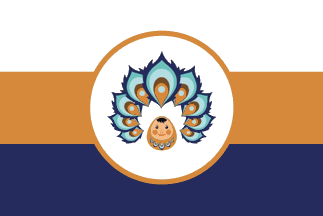 image submitted by JTK, 11 May 2021
image submitted by JTK, 11 May 2021
This was posted on the FOTW Facebook site: "This Bamar ethnic flag was drawn on May 2, 2021 by the Bamar Flag
Implementation Committee. This has become the official flag of the
Bamar ethnicity most populated in Myanmar
Representations:
White=Equality
Orange= Dawn or being new
Blue= Freedom or Peace
It composed of peacock wings and Pyit Taing Htaung within a circle.
Peacock wings mean the national sign of hte Bamar people.
Pyit Taing Htaung is the Myanmar national toy. It means "each time you
throw it, it stands up". Therefore, the toy represents resilience,
perseverance, and the ability to pick oneself up or to never give up
as important values.
We are proud of our flag."
JTK, 11 May 2021
The Kachin Independence Organization (KIO) counts more than five thousand regular soldiers. The Kachin people numbers some two million persons, who live in northernmost Myanmar.
Jaume Ollé, 13 August 1996.
"Kachinland (Kachin Independence Orgnization) - Burma". Similar to the above, but with stripes of equal height and smaller emblem. Identical to "Hainan".
Ivan Sache, 16 Sep 1999
" Kachin Independence Army (K.I.A.) signed under the direction of Brang Seng, former director of Kachin Baptist High School in Myitkyina, in March 1976 with the Burmese Communist Party [a pro-chinese rebellion movement opposed to the Burmese government] a cooperation agreement, which was considered as ideological by the Communists but only tactical by the Kachin. On 10 October 1980, a new agreement stated that the alliance was based on mutual respect. Therefore, China provided directly the Kachin with weapons in exchange of illegal exportations. The Kachin movement was reunified in 1981." [eun]
Ivan Sache, 16 Sep 1999
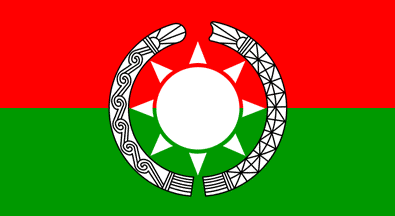 image by
António Martins-Tuválkin, 14 June 2007
image by
António Martins-Tuválkin, 14 June 2007
Based on image at: http://www.kachinland.org/kno_2006/About_kno/constitution.htm
Quoting from the above site:
CONSTITUTION
Organization Name: It shall be called the Kachin National Organization or by its
acronym, KNO.
Organization Homeland: It is a statehood and shall be called Kachinland.
Organization Emblem: Historic ceremonial poles representing Male and Female with
a Harbinger Drum.
Organization Flag: Four colors with traditional meanings:
Evergreen: Truth and Faith
Red: Bravery and Sacrifice
Blue: Loyalty and Peace
White: Honesty and Integrity
Sun: Source of Life
Ceremonial Poles: Symbol of Cultural Heritage
Mikhail Revnivtsev, 13 June 2006
It is a red over green ~5:9 horizontal
bicolor with large white emblem overall. This consists of a
Namibian-style sun (i.e., disc surrounded by stubby triangle outwards for
rays) with eight rays surrounded bracket-like by two arching elements (the said
ceremonial poles?), these with black edging and lining. Both bottom ends of
these show a fringe-like pattern; the hoist side pole top end is convex while
the fly-side is convex, both are filled with a stylized sunrise/sunset motif.
The main patterns are unequal: The hoist side pole is filled with a wave-like
coiled motif repeating 6,5 times while the fly side pole is filled with six
radial cells stroked on their diagonals and pseudo-apothems.
António Martins-Tuválkin, 14 June 2007
Karen
The national flag of Karen (Republic of Kawtholei) according Franciae Vexilla
#20/66, December 2000, by J. Renault & H. Calvarin.
Jaume Ollé, 25 January 2001
See also:
The Karenni Nation Progressive Party (KNPP) has 200 regular fighters (Kayaw, Kaya, Manamanaw, Shao, Pa-O and others). The Karenni number approximately 300,000.
An alternate version of the flag of the Karenni States is reported to have equal width stripes, red, white and blue, with a central motif in black consisting of a central 12-pointed star surrounded by four frogs in an inner circle and four fish in an outer circle.
Murray Menzies, Karenni Govt. South Pacific Regional Charge d'Affaires, 1 March 1998
In 'Franciae Vexillae' # 4/50 (January 1997), M. Corbic reports the history of the Karenni flag, as follows:
krnni.gif) image
provided by Jaume Ollé, 29 December 2012
image
provided by Jaume Ollé, 29 December 2012
Recently the Minister of Foreign Affairs Mr. Abel Tweed and the South Pacific regional charge d'affairs sent me much documentation and I redrew the flag according to the official documentation. The flag is three horizontal stripes of red, white and blue, with the emblem in the center. Several times is reported the same flag but with the central stripe double wide. The official name of the country is the United Karenni independent States, but is abrreviated United States of Karenni. The states are Bawlake, Kyebogyi and Kantarawaddy. The emblem has four fish and four toad and a twelve pointed star.
Jaume Ollé, 15 June 1998
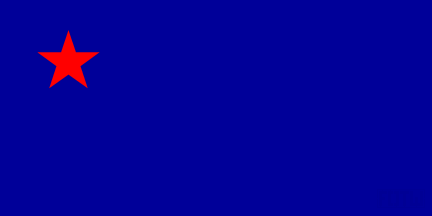 image by Eugene Ipavec, 12 September 2006
image by Eugene Ipavec, 12 September 2006
An article in The Irrawaddy News Magazine from November 2005 shows the flags of
the Mon nation and of the Karenni National Progressive Party. The KNPP flag is
completely different from those above. Source:
http://www.irrawaddy.org/aviewer.asp?a=5171&z=102.
Valentin Poposki, 11 September 2006
See also:
"Lahu National Organization (Lahus) - Burma."
Similar to above, but with stripes of equal height. I have found mention of Lahu tribes in Laos but not in Burma.
Ivan Sache, 16 Sep 1999
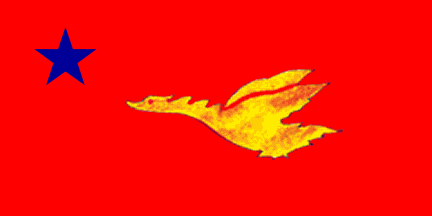 Eugene Ipavec, 12 September 2006
Eugene Ipavec, 12 September 2006
Nickname: Flag of the Golden Drake Flying. The New Mon State Party (NMSP) has 3,000 regular fighters (mostly Mon). The Mon people number approximately one million.
Jaume Ollé, 15 August 1996
An article in The Irrawaddy News Magazine from November 2005 shows the flags of
the Mon nation and of the Karenni National Progressive Party. Source:
http://www.irrawaddy.org/aviewer.asp?a=5171&z=102.
Valentin Poposki, 11 September 2006
In early 1988 I was in Myanmar (Burma) teaching English for The New Mon
State Party. On one occasion while I was talking with some monks, I was told
that the bird on the flag was called an “Ark”. The story behind it started 4000
years ago when the Mon left their lands up near China, on boats. The story goes
on to reveal that they later were in open seas when a bird (pictured on their
flag) landed on their boat. This bird had a twig with leaves in its mouth. So
the boats traveled in the direction that the bird had come from, and this was
how the Mon first arrived in Myanmar (Burma). I remember this well because of
the similarity it has to another well-known story set in a similar time period.
The most notable part I thought was that the bird was called an Ark. I presume
that “Flag of the Golden Drake Flying” is a western description, have you ever
heard this story of the Ark before?
I have no way to reference the story as
I heard it only via word of mouth, however, I have no reason to doubt the
bona fide of the persons I spoke with including the president of the Mon
Nation, Buddhist monks and officers of the Mon Revolutionary Army.
Lash,
1 January 2014
Reported as a flag of the Arakan State in a letter from George Pasch to Thanh-Tam Le dating from May 1982. The bird is probably a sheldrake.
Than-Tam Le 09 June 1999
"New Môns State Party (Môns) - Burma." Similar to the first one above but with different bird (flying drake represented in profile, in "cruising flight" position.) Ivan Sache, 16 Sep 1999
"The Môn ethnic group established in the past rich and powerful kingdoms in Burma and Thailand, but is nowadays a minority trying to preserve its identity, in spite of the fiction of a "Môn federate state' in Myanmar. At the end of the 70's, they were ca. 1,000,000 Môns in Myanmar and 60,000-100,000 of them in Thailand. The ethnic emblem is a species of duck, which represents the brahmanic 'hamsa' [the mount of God Brahma]. Môn language belongs to the Môn-Khmer family, with one of the oldest writing system in the area." [eun]
Ivan Sache, 16 Sep 1999
After the British-Burmese war, British troops evacuated the occupied regions of
Syriam, Rangoon Prome, etc... The Mon (called by the Burmese Talaing) were the
majority in Syriam, and expected the formation of a national state under British
protection. However they did not obtain it, and then, allied with the
Karen (that also expected a British protected state) revolted and proclaimed the
Kingdom of Talaing. Maong Sat, brother-in-law of the Burmese king, ethnic Mon
and governor of Syriam, was proclaimed king (1826). But Burmese troops occupied
the kingdom and suppressed it in 1827.
Jaume Ollé,
30 June 2001
Franciae Vexilla reported another flag supposed
to be from Pegu, a Mon Kingdom in fact called Ramanyadesa (capital Pegu),
according to Norie and Hobbs, but Vexilologie
15 shows a similar flag attributed to Sanove. Perhaps is the flag hoisted by the
kingdom of Talaings (Mon) when was annexed to Britain in 1825/26 (Talaing
kingdom I believe that was the remain of the old Pegu kingdom, and was vassal of
Ava/Burma kings).
Jaume Ollé, 28 June 2001
See also:
"Surrender of the P.S.L.A. was effective in May 1991." [eun]Ivan Sache, 16 Sep 1999
 image by Zachary Harden, 22 May 2021
image by Zachary Harden, 22 May 2021
"Surrender of the Pa-Os was effective in April 1991." [eun]Ivan Sache, 16 Sep 1999
"Since 1950, executives of the Union Pa-O National League (PNLP) and senior Pa-O national leaders have drafted the constitution, which is essential to an association. The constitution includes an introduction; There are eight chapters and a conclusion. In Chapter 1, Article 3, the proportions of the flag are 9 feet long; The width of the flag is 5 feet (2 feet, 6 inches) and the base is dark green. The length of the original dark blue (4 feet, 6 inches); Width (2 feet, 6 inches) At the top corner of the dark blue should be a large white star eighteen inches in diameter. The meaning of the stars and colors of the Pa-O national flag are as follows: The meaning of the star is that the stars do not stop on their way, but continue their journey without abandoning their journey. Since the creation of the world, it has been characterized by its ability to have its own light and its own, and to represent all Pa-O tribes as a single star. Dark green is youthful and refreshing. Lightweight and agile. It means to be happy. Red is bold; Sharpness It means abolition. Dark blue is light; Dignity; It means trust. The above Pa-O national flag was hoisted in 1955."Zachary Harden, 22 May 2021, quoting from https://www.pa-onational.org/2013/07/blog-post.html
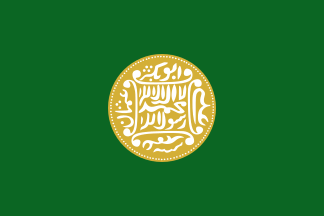 image by Tomislav Todorovic, 25 March 2023
image by Tomislav Todorovic, 25 March 2023
Source: Wikimedia Commons
A green flag with a small seal bearing an ornate pattern of white on brown. The reliability of this flag is unknown. [Ed.]
The Rohingya flag is the cultural and ethnic flag of the Rohingya and was first mentioned by the scholar A.F.K. Jilani, who documented its creation in the middle of the 20th century, probably shortly before the independence of Burma, around 1946 or 1947. Although little used it existed for the rest of the century, as published before 2000 in Flag Report . On May 20, 2018, the Rohingya Language Academy established an updated design that was made public for its widespread use and is currently used by all Rohingya communities around the world and sometimes also in Myanmar where it is not legally recognized or authorized. The flag is green with an old gold coin with white Arabic text; green represents peace, gold prosperity and white purity. The text is the shahada (There is no god but Allah and Muhammad is the prophet of Allah) surrounded by the names of the first four caliphs, Abu Bakr (above), Omar (below), Othman (left) and Ali (right). The ratio is 2:3; the diameter of the coin is half the height (in the past, as it was not regulated, the most common representation was 1/3). The coin was used in the kingdom of Arakan in the 16th century. The colors are Hex #0b6623 (green), Hex #d4af37 (gold), and Hex #fff fff (white). The coin represents the Rohingya civilization and the lost sovereignty of Arakan; the shahada represents the faith of the Rohingya and the four caliphs represent the role model. The flag must always be honored and must be manufactured in such a way that the shahada can be read on both sides, that is to say from right to left; it cannot be hoisted half-mast or in dirty places because it includes the name of Allah. It cannot be hoisted upside down either.
Jaume Ollé, 21 March 2024
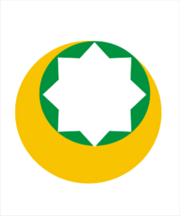 image by Tomislav Todorovic, 25 March 2023
image by Tomislav Todorovic, 25 March 2023
Yesterday on Catalan TV8 I saw a short news item, related to the conflict
between the Rohingya people and the government of Myanmar as denounced by
Amnesty International. A supposed Rohingya demonstration with no caption
appeared on the screen for a few seconds, showing an unknown flag, that must be
from a Rohingya organization or from a supporter organization.
Jaume
Ollé, 20 December 2016
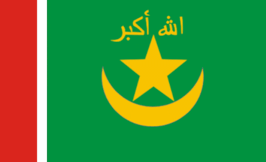 image by Tomislav Todorovic, 19 March 2023
image by Tomislav Todorovic, 19 March 2023
Rohingya relief organization created 2006 (in exile in Malaysia) with the name Kyauk Taw Family. In 2012 changed name to Arakan Kyauk Taw Rohingya Council; and 2013 another change to the current name Arakan Rohingya Council, serving all the rohingya from inner and outer Myanmar
No photo of this organization, only a drawing of the flag in their Facebook page.
Can be than before this flag, an old one was vertical white with a yellow half moon and a white eight-pointed star bordered with green, but identification is not sure.
Jaume Ollé, 18 March 2024
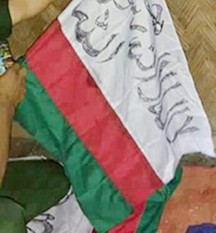 image by AFP/Myanmar Armed Forces/Stringer, located by Jason Saber, 14 October 2016
image by AFP/Myanmar Armed Forces/Stringer, located by Jason Saber, 14 October 2016
A flag in GIF format is seen here. The
flag is a horizontal flag, equally divided into three horizontal
stripes, being white (top), green (middle) and red (bottom), and on
the white fringe there is supposedly the Shahada in black
color font.
It is the "Arakan Rohingya Salvation Army (Burmese: အာရ်ကန်ရိုဟင်ဂျာ
ကယ်တင်ရေးတပ်မတော်; abbreviated ARSA), also known by its
former name Harakah al-Yaqin (meaning Faith Movement in English). It was formed in 2013, following the 2012 Rakhine State riots. Source: Wikipedia
Esteban Rivera, 25 May 2018
The captured flags show it being Colombia-like (2:1:1) with the stripes.
Zachary Harden, 25 May 2018
 image submitted by JTK, 12 May 2021
image submitted by JTK, 12 May 2021
This was posted on the FOTW Facebook site: "That is Taungyoe ethnic people's flag also called hill tribes (the brotherhood of Danu ethnic people who live in Myanmar).
In the flag of the hill tribes, the big star represents Myanmar and the three small stars represent our three responsibilities. Red symbolizes boldness and blue symbolizes loyalty and peace. The symbol of the hill tribes is the Yadana White Horse."
JTK, 12 May 2021